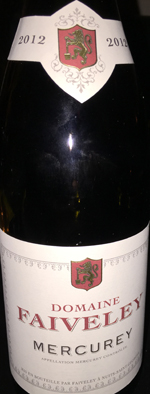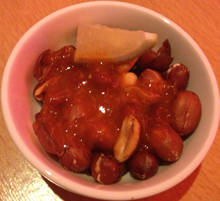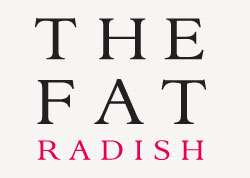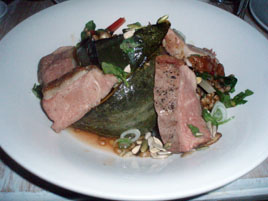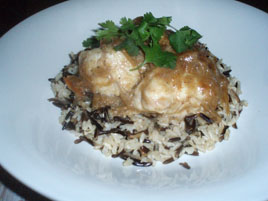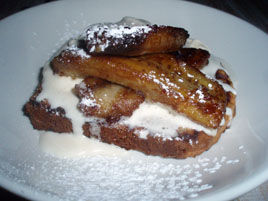

Note: Mission Chinese closed in November 2013 after the Department of Health found a major rodent infestation from a nearby construction site. Chef/owner Danny Bowien had hoped initially to fix the problem and re-open, but eventually concluded that the space was un-fixable. In the interim, Bowien ran a much-admired Mission Chinese pop-up at Frankies 457 in Brooklyn, and later at Mile End in Manhattan. As of September 2014, Bowien planned to re-open in the Lower East Side space that was briefly Rosette.
*
 You’ve got every right to be skeptical of hyped restaurants, including Mission Chinese Food, which opened recently on the Lower East Side in the old Rhong Tiam space.
You’ve got every right to be skeptical of hyped restaurants, including Mission Chinese Food, which opened recently on the Lower East Side in the old Rhong Tiam space.
Mission Chinese deserves that hype. The food is clever, well made, and inexpensive. The chef, Danny Bowien, is a Korean from Oklahoma. The food doesn’t replicate any of the well known Chinese cuisines. According to the Times, the chef calls it “Americanized Oriental food.”
 Among recent openings, perhaps RedFarm is the closest precedent—not that Bowien’s cuisine resembles Joe Ng’s in any but the vaguest way, but they both take Chinese cuisine as a point of departure, cooking with local ingredients and adapting the tradition to their own style.
Among recent openings, perhaps RedFarm is the closest precedent—not that Bowien’s cuisine resembles Joe Ng’s in any but the vaguest way, but they both take Chinese cuisine as a point of departure, cooking with local ingredients and adapting the tradition to their own style.
Reservations aren’t taken, except for twelve seats at and around the bar. At most reasonable meal times, expect to wait an hour or more. I was seated immediately at 5:45pm on a Tuesday evening. By 7:00pm, when I left, standees were already three-deep at the bar, and the line to get in snaked out the door.
(At least there are other useful places in the neighborhood to cool your heels while you wait—an option not available at the city’s other hot new no-reservations Asian joint, Pok Pok NY, on the Brooklyn waterfront, fifteen minutes’ walk from the nearest subway, and not near anything else of interest.)
The restaurant is similar to a sister establishment in San Francisco, making Mission Chinese one of the very rare examples of a restaurant that has succeeded here after first succeeding somewhere else (which is likewise true of Pok Pok NY). New York is not usually so kind to imports.
 The place is a bit ramshackle. You go down a few steps, through a narrow corridor, past the kitchen, and into what looks like a back yard with a makeshift roof that they ran out of money to finish properly. What will that porch will be like when the weather turns cold?
The place is a bit ramshackle. You go down a few steps, through a narrow corridor, past the kitchen, and into what looks like a back yard with a makeshift roof that they ran out of money to finish properly. What will that porch will be like when the weather turns cold?
But the price is right, with small plates $4–13 and large ones $6–15. The restaurant donates 75 cents from each entrée to the Food Bank of New York City, a remarkable gesture for such an inexpensive place. The same amount from every cocktail sold will go to a different charity each month.
Even the so-called “small plates” are ample. I ordered one of each, and didn’t finish them. I’d like to try more, though I’m not sure when I’ll be able to return at an hour when the wait would be acceptable to me.
The menu continues to evolve: just today, Bloomberg’s Ryan Sutton tweeted that there are two new dishes: $10 red braised pig tails & $9 “married couple’s” beef (tongue, heart, tripe, numbing chili).


Thrice-cooked bacon ($11.50; above left) is a devilish concotion, with Shanghainese rice cakes, tofu skin, bitter melon, and chili oil. It merits two “chili peppers” on the menu, and the chef ain’t kidding. It’s a hot dish.
Tea-smoked eel ($9; above right) has rotated off the menu as of today, and from the photos I’ve seen the chef makes it a number of different ways. It was served as an open-ended and over-stuffed dumpling filled with eel, and (I believe) pulled ham, celery, and soy. This was actually the smaller of the two plates, but it came out later and offered a welcome contrast to the blistering-hot bacon.
Cocktails, like the food, are clever, amply portioned, and inexpensive. The One-Eyed Jack ($9) is a characteristic example, with Soju (a Korean vodka), Umebashi (a Japanese plum), mint, and mirin (a Japanese condiment). Another, the Michelada, was made with smoked clam juice, chili, szechuan pepper, and beer.
No, these aren’t grandpa’s cocktails.
I arrived just after the health inspector and was warned the food would be delayed. (I didn’t hear what grade they got, but apparently the gentleman left without incident.) One of the cocktails was silently comped, probably for that reason. Aside from that, service at the bar was just fine. I can’t judge how long the food would take on a normal evening.
In New York, you could eat in another Chinese restaurant every day for years, and not run out of new places to try. There are specialist bloggers who have done practically that. For an assessment of exactly where Mission Chinese Food fits in this vibrant and widely varying community, I would refer you to them.
I can only say for myself, that Mission Chinese has some of the cleverest and most enjoyable inexpensive food I’ve had in quite a long time.
Mission Chinese Food (154 Orchard St. btwn Stanton & Rivington, Lower E. Side)
Food: Chinese-influenced, with pan-Asian and American ingredients
Service: Fine for such a casual establishment
Ambiance: A ramshackle back porch
Rating: ★★
Why? Some of the cleverest and most original food I’ve had in a while
 Monday, April 6, 2015 at 08:21PM
Monday, April 6, 2015 at 08:21PM  The concept was daring for late 2013: a $55 five-course set menu from two chefs most people (then) had never heard of. Apparently they never got the memo: that’s not The Way We Eat Now. Diners want sharable small plates, to order either a short snack or a multi-course degustation at their whim. Or, do they? Contra was willing to bet the opposite.
The concept was daring for late 2013: a $55 five-course set menu from two chefs most people (then) had never heard of. Apparently they never got the memo: that’s not The Way We Eat Now. Diners want sharable small plates, to order either a short snack or a multi-course degustation at their whim. Or, do they? Contra was willing to bet the opposite. Contra did it anyway, the rave reviews rolled in, and the rest is history. Last week, the restaurant finally got around to raising its prices. Thursdays through Saturdays, the price will be $67 for 6–8 courses. On Tuesdays and Wednesdays, the original five-course menu will be a hair less expensive than before, at $53. (You can order à la carte at the bar.)
Contra did it anyway, the rave reviews rolled in, and the rest is history. Last week, the restaurant finally got around to raising its prices. Thursdays through Saturdays, the price will be $67 for 6–8 courses. On Tuesdays and Wednesdays, the original five-course menu will be a hair less expensive than before, at $53. (You can order à la carte at the bar.)


